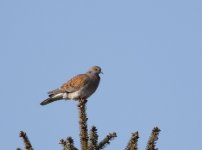I've decided to take the step into DSLR photography. I've previously used a superzoom that was able to document what I saw, but with very clear limitations in terms of usability and picture quality. I was therefore hoping for a leap forward with my new equipment (see specs in the thread title). However, after a few trips with the new camera and playing around with the settings, I still feel like I'm far from where I want to be.
As an example, I'm attaching a photo of a European Turtle Dove. It was taken handheld from ~30-40m at the max lens range (400mm) with the one-spot AF pointing at the middle of the bird. It's obviously been compressed here for the forum, but the original looks about the same (= equally unsharp). I've shot a couple of hundred photos with the new setup and I just can't seem to get beyond this quality, so I don't think this is a matter of "just take a few more shots". The same bird was photographed by someone else, roughly at the same time (https://dofbasen.dk/image_proxy.php?mode=o&pic=31693125_20230406070214_731290604.jpg). According to the file info, that person used a Coolpix P950, which I feel should be inferior to my setup. To give some background for this photo, it was taken in great light at the end of the day and it was starting to get a bit cold outside. Seems like pretty optimal conditions to me.
Anyways, any suggestions on what I can try to improve the sharpness? (preferably "beginner-friendly" advise )
)
As an example, I'm attaching a photo of a European Turtle Dove. It was taken handheld from ~30-40m at the max lens range (400mm) with the one-spot AF pointing at the middle of the bird. It's obviously been compressed here for the forum, but the original looks about the same (= equally unsharp). I've shot a couple of hundred photos with the new setup and I just can't seem to get beyond this quality, so I don't think this is a matter of "just take a few more shots". The same bird was photographed by someone else, roughly at the same time (https://dofbasen.dk/image_proxy.php?mode=o&pic=31693125_20230406070214_731290604.jpg). According to the file info, that person used a Coolpix P950, which I feel should be inferior to my setup. To give some background for this photo, it was taken in great light at the end of the day and it was starting to get a bit cold outside. Seems like pretty optimal conditions to me.
Anyways, any suggestions on what I can try to improve the sharpness? (preferably "beginner-friendly" advise






